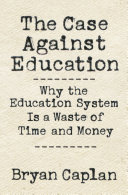Summary
Human capital model
The foundation of the drive to increase educational attainment across the board is the human capital model of education, which began with the research of Gary Becker. [2] The model suggests that increasing educational attainment causes increased prosperity by endowing students with increased skills. As a consequence, subsidies to education are seen as a positive investment that increases economic growth and creates spillover effects by improving civic engagement, happiness, health, etc.
Caplan argues against the model due to several contradictions, though he does not dispute that higher educational attainment is strongly correlated with increased individual income. He highlights how most adults rarely remember much of what they were taught in school not related to their career besides English and math, and even the latter two are inadequate. He also analyzes the sheepskin effect, where the largest increases in income from higher educational attainment occur after attaining an academic degree, but not for those who dropped out of college despite usually having completed some courses. He finally criticizes educational inflation, the increasing educational requirements for occupations that do not require them, as indicating educational attainment is relative and not nearly as beneficial for society as portrayed.
Signaling model
The main alternative to the human capital model of education is the signaling model of education. The idea of job market signaling through educational attainment goes back to the work of Michael Spence. [3] The model Spence developed suggested that, even if a student did not gain any skills through an educational program, the program can still be useful so long as the signal from completing the program is correlated with traits that predict job performance.
Throughout the book, Caplan details a series of observations that suggest a significant role for signaling in the return to education:
- Intelligence [4] [5] [6] and conscientiousness [7] are known predictors of educational and occupational success, and are relatively stable [8] [9] throughout a person's life
- International estimates of the effect of an additional year of education on national income are much lower than those estimating the impact of an additional year of education on personal income [10] (p. 114-118 [1] )
- Many students forget material over the summer and after the end of a class (p. 39-40 [1] )
- Students look to take courses that offer easy As, instead of more difficult courses
- The sheepskin effect seems to be fairly large (p. 97-102 [1] )
- Transfer of learning to other disciplines appears to be low or nonexistent (p. 50-59 [1] )
Given the above signs of signaling, Caplan argues in ch. 5–6 [1] that the selfish return to education is greater than the social return to education, suggesting that greater educational attainment creates a negative externality (p. 198 [1] ). In other words, status is zero-sum; skill is not (p. 229 [1] ).
Cost–benefit analysis of going to college
For many students, Caplan argues that most of the negative social return to pursuing further education comes from the incursion of student debt and lost employment opportunities for students who are unlikely to complete college (p. 210–211, ch. 8 [1] ). He suggests that these students would be better served by vocational education.
This page is based on this
Wikipedia article Text is available under the
CC BY-SA 4.0 license; additional terms may apply.
Images, videos and audio are available under their respective licenses.
